Introduction
Information and communication technology (ICT) transformed communication, instruction, and work practices (Vázquez-Cano et al., 2020) . Similarly, universities have been experiencing a metamorphosis for a few years now, primarily as a result of digitalization, internationalization, and student characteristics, as well as information and communication technologies. This process presents an obstacle to higher-education institutions in terms of the competencies that faculty and students must attain, as well as the adaptation of curricula to these new competencies (Veretekhina & Novikova, 2019). As a result, teachers should indeed perform an innovative role and exploit new technological innovations.
It is critical to have a closer look at how students are engaged in classroom activities to advance the quality of their learning. Students today are excited to continue their studies in tandem with technological advancements, and digital transformation creates a dynamic, secure, and adaptable learning environment (Singh et al., 2021). An engaging innovation that has become significant in the field of education is Augmented Reality (AR) (Lee, 2012). Incorporating AR into the educational context could promote interaction and boost learning outcomes, engagement, motivation, and collaboration (Alzahrani, 2020; Billinghurst, 2021; Chen et al., 2020; Radu et al., 2021). However, the development of AR as an educational tool in the context of higher education is dependent on the direction of implementation, students’ access, and infrastructure (Lee, 2012).
AR has three features (Azuma, 1997): 1) It blends real and virtual visuals, is interactive in real-time, and has 3D virtual graphics. Azuma's (1997) concept of AR outlines the technology that is required to implement it. Real and virtual images require display technologies. Real-time interaction requires interface technology. Three-dimensional AR content requires tracking equipment. These tools are accessible in research laboratories, but existing cameras, GPS and sensor systems, high-resolution displays, fast connectivity, and powerful CPUs and graphics processors of modern smartphones are the most prevalent ways for users to experience augmented reality (Apple, 2020; Google, 2020). A user can examine virtual items in the real world through the camera view on their smartphone's display. The fact that mobile augmented reality programs such as Pokemon Go have been played over a billion times demonstrates how accessible the technology is (NintendoSoup, 2019). Rosenberg (2022) predicts that the metaverse is the future of technology AR will dominate the integration of the real and virtual worlds. He categorized the metaverse's core terms as persistent, immersive, simultaneous, and presence.
The field of AR has become one of the most promising areas of digital graphics during the past few years. During this period, countless applications have been incorporated, boosting AR in daily life (Rhodes et al., 2017). Such breakthroughs have impacted academia through new digitization processes and learning devices (Joo-Nagata et al., 2017). Yang et al. (2020) observed that these new actions and concepts are linked to existing technology such as digital learning, ubiquitous learning, mobile learning, and game-based learning.
Huang et al. (2016) postulated that technological advancements in academic contexts enable collaboration between diverse disciplines of knowledge to develop complementary techniques, content, and learning outcomes. Indeed, Alkhattabi (2017) hypothesized that AR would facilitate learning. Le & Nguyen (2020) argued that AR in learning offers portable, low-cost, stress-free solutions. However, implementation difficulties have been discovered. Akçayır & Akçayır (2017) identified usability and technology experience issues, while Alzahrani (2020) identified pedagogy and technology-related difficulties.
Several previous studies have examined the benefits and drawbacks of using AR in educational settings (Alzahrani, 2020; Theodoropoulos & Lepouras, 2021). However, studies investigating various types of AR-based learning applications in the language-learning context are still scarce, particularly in the context of higher education. To fill this gap, an in-depth investigation of this issue is required. As a result, a proper discussion of the advantages and challenges revealed in this study may assist in proposing best practices for future research to maximize the potential of this technology.
Concept of Augmented Reality
Prior studies have already dealt with AR innovations Akçayır & Akçayır, 2017; Chaudhary, 2019; Hincapie et al., 2021). Smartphones with high-resolution screens, cameras, and sensors have refocused attention on AR, which is advancing on the well-established technological underpinnings afforded by these devices. In advance of screen technology that easily integrates reality and augmented content, major corporations have been driven to incorporate high-quality AR into real-world environments to become the dominant AR platforms of the future (Chaudhary, 2019).
There are diverse definitions of AR. Hincapie et al. (2021) defined AR as an immersive technology that augments the user's sense of reality by providing contextual information. Chien et al. (2019) also underlined AR as a computer-generated blend of virtual and real-world imagery. Similarly, Akçayır and Akçayır (2017) mentioned that AR allows users to view virtual items in the real world, creating the illusion that they are real. Azuma (1997) identified three key features of AR: blending real and virtual; real-time interactivity; and 3D integration and rendering.
Many acronyms and words are used to describe the present and potential AR technologies. AR inserts virtual elements into the physical world, while VR (virtual reality) removes them. AR requires the user to concentrate on both the digital and actual realities, making it different from VR (Oh & Bailenson, 2017). Milgram et al. (1995) stated that AR is also called “mixed reality” (MR) because of the merging of real and virtual aspects. Entirely real and fully virtual are at opposite extremes of the spectrum, while the middle area belongs to MR, which includes AR and VR. MR was once viewed as a computer-mediated reality that allowed the insertion or exclusion of identifiable elements. CMR combines MR, AR, and VR. (Mann et al., 2018). Extended reality (ER) is another abbreviation for these advanced technologies.
Previous Studies on Mobile AR-Based Language Learning
Mobile AR has been widely used in education as a result of the rapid advancement of digital technology, and it promotes theoretical improvements, acquiring knowledge, curiosity, and enjoyment. (Chen, 2020; Yoon & Kang, 2021). Previous research has also explored mobile AR-based learning activities for enhancing students' learning based on multimedia learning design principles (Goff et al., 2018; Wu et al., 2018).
Yang & Mei (2018) carried out a case study using semi-structured interviews and direct observation as data collection. It aimed to gain a deeper understanding of learners' perceptions as well as experiences of AR-based learning in language courses. Students were recruited to obtain entry to an AR stroke-by-stroke-based training animation for recognizing Japanese orthography with a personal mobile phone. Thematic analysis findings demonstrate positive perceptions and attitudes toward engaging in AR-based language learning experiences. However, this study delves into the difficulties that users face when utilizing technology. As a result, the faculty's position is crucial in guiding the students to use AR platforms and engaging them in enjoyable sessions.
Another mixed-method study was undertaken by Ebadi et al. (2021). They attempted to investigate how AR affected undergraduate EFL learners' reading comprehension and attitudes. The intervention group, as well as any differences in student comprehension between classes, were quantitatively examined using independent and paired sample t-tests. The results indicated that the intervention class group had significantly higher reading comprehension than the control group. Evidence from semi-structured interviews revealed that students enjoyed using AR and preferred it to traditional approaches. Surprisingly, AR increased students' enthusiasm for comprehending tasks as well as their eagerness to use AR language learning platforms in EFL settings.
Mobile AR with Aurasma
Augmented reality with Aurasma creates 3D visual effects with audio and motion. Yang & Mei (2018) evaluated students' views and experiences with a mobile augmented reality-based stroke-by-stroke animation guide for language learning and discovered that they had positive perceptions. The findings indicate that Aurasma enhanced efficient vocabulary acquisition by allowing learners to experience visual effects for vocabulary items, thereby improving meaning comprehension (Redondo et al., 2020).
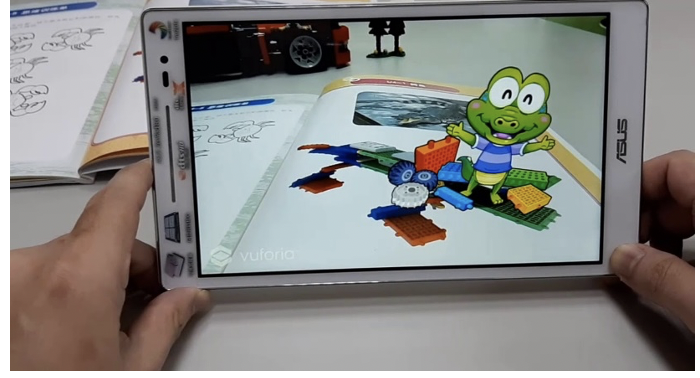
Figure 1: Mobile AR with Aurasma
ARVEL
Chen (2020) used Augmented Reality Video-Enhanced Learning (ARVEL) to assist students in enhancing their English mastery. Using Xcode, Vuforia, and Unity 3D, an ARVEL system was created that included a discussion environment and two procedures: ARVEL procedures and discussion learning procedures. ARVEL consists of three modules: AR, learning material, and video control; the context-aware learning mechanism consists of three modules: learning task, prompt, and process control. Furthermore, multiple databases were created to support the two systems, including the task bank and the educational resource database. This method has been shown to improve students' academic achievement and motivation. AR video-enhanced learning methods are more popular among students. Furthermore, Yip et al. (2019) confirmed that students who learned with AR videos had better learning outcomes and satisfaction than those who learned with a handout.
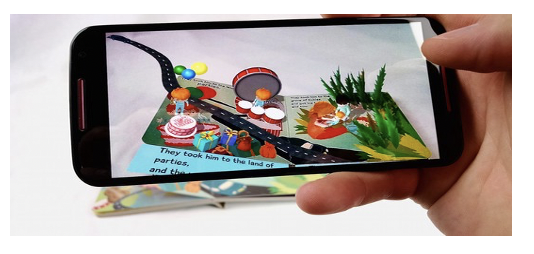
Figure 2: Vuforia for 3D Unity / ARVEL
AR Multimedia Textbook (ARMTB)
Lai et al. (2019) designed an AR-based science learning system called AR Multimedia Textbook (ARMTB) for science learning at the primary level using the contiguity concept of multimedia instruction. The system successfully increased the students' motivation and academic achievement in reading, while reducing their feelings of cognitive overload. His study also employed augmented reality technology as a contextual scaffold to enhance EFL students' learning performance.
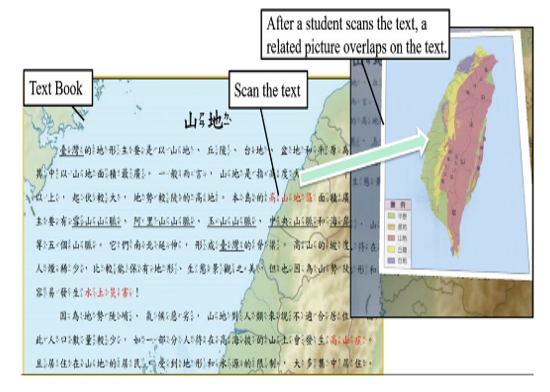
Figure 3: ARMTB
AR Picture Book
Hung et al. (2017) investigated the effectiveness of student training using three kinds of learning resources: a picture book, direct interaction, and an AR graphic book. They discovered that when compared to the other two groups, students who used the AR learning resources were the most satisfied and engaged. Furthermore, Cheng & Tsai (2016)investigated parents' perspectives on AR instruction to better understand how both children and their parents react. Parents in child-parent pair communicative groups and groups of children have generally positive viewpoints about AR classroom teaching, such as viewing AR learning as increasing motivation and supporting a deep understanding.
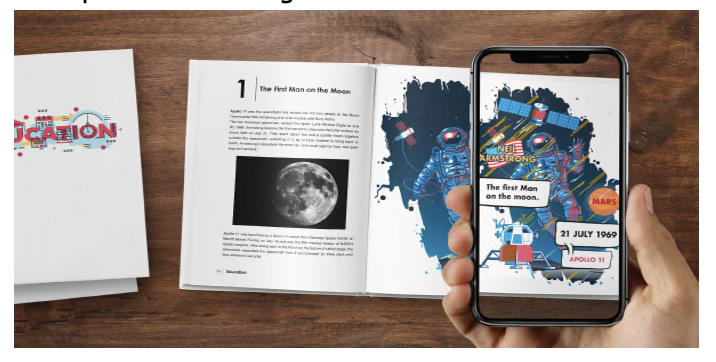
Figure 4: AR Picture Book
Mondly
Powers (2019) noted that Mondly makes it easier to achieve fluency. The app includes augmented reality, a kid-friendly version, and even a business version, but the most appealing feature is the virtual reality mode. Users can virtually travel the world and discover various environments and situations that enable them to practice their language. Sorrentino & Spano (2019) described Mondly as a platform that includes a website as well as iOS and Android mobile apps. It offers free and premium versions in 33 languages. The learning method entails a dialogue between the subscriber and various virtual characters equipped with advanced technologies to provide grammar and pronunciation feedback. The platform does not include a content-authoring environment according to Altinkaya & Smeulders (2020), Mondly is one of the most interesting platforms using Artificial Intelligence technology.
Simonova & Kolesnichenko (2022) noted that Mondly is intended to help students learn all elements of the English language, including grammar, vocabulary, pronunciation, writing, listening, and reading. It uses augmented reality to teach English and improve comprehension. One of its strengths is the ability to detect a person's speech against a background of varied noises, thus simulating real-world discussions with a virtual figure. This application can help students enhance their acquisition, pronunciation, speech practice, memorization of new words, and overall understanding of the English language.
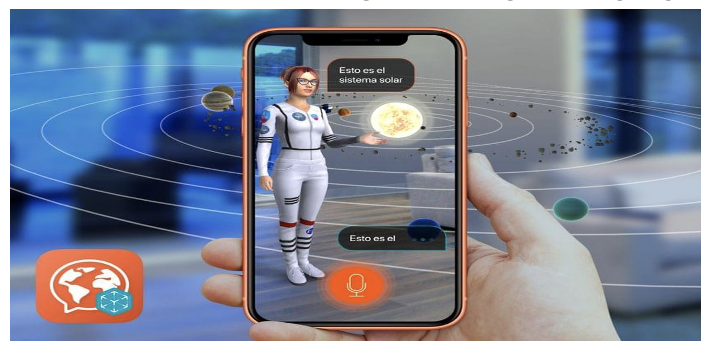
Figure 5: Mondly
Rumii
Rumii was also discussed by Simonova & Kolesnichenko (2022). It is an application for group virtual classrooms that contain 3-D objects, a board, a touchscreen demonstration, and more. Constructing cognitive maps in augmented realityfacilitates the acquisition of new English topics and vocabulary. This application enables students to link concepts using images and tags, and then see these connections in three dimensions. They are more effective than standard lectures because they help students retain all of the information and exhibit their creative and independent thinking abilities. Furthermore, the learner can be accompanied and instructed by their instructor during “field trips” on Rumii. This option as it is simple to use with a personal computer (Shabkhoslati, 2021).
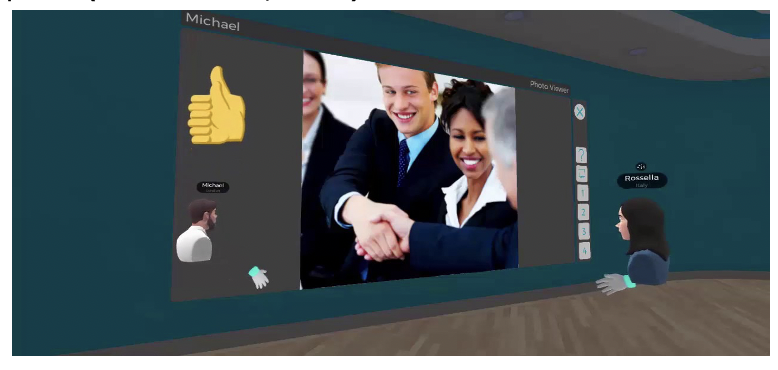
Figure 6: Rumii
Other Systems
Siri and Alexa are powerful tools to enhance learners’ speaking performance. They assist learners with computer-assisted pronunciation and voice recognition (Bibauw et al., 2019; El Shazly, 2021). Siri in particular may have signaled an irreversible switch toward the "intelligent personal assistant" framework: simply say what you want, and the system will automatically determine the best action to take (Bellegarda, 2013). Alexa provides services such as managing a user's calendar, modeling good manners for toddlers, and providing companionship (Woods, 2018).
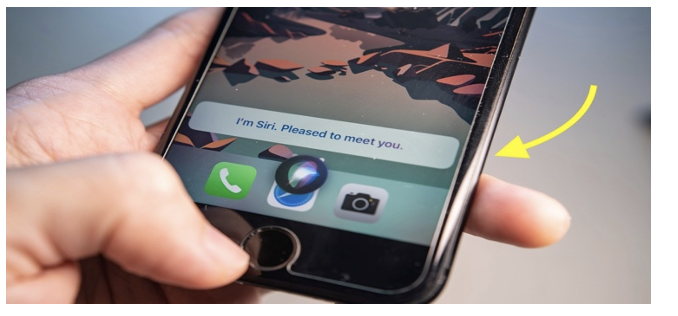
Figure 7: Siri
Simonova & Kolesnichenko (2022) highlighted several ARs in language learning: The Tour Builder and The Tour Creator are essentially identical in their functions. They build their journeys around a city, a country, or just virtual trips to any museum. Students can immerse themselves in a virtual city or museum that looks real by using these services. It shows creativity and improves speaking skills. As a tour builder and guide, a student can use his English to communicate with foreign visitors. Google Cardboard offers learners visuals for intercultural lessons. Learners are able to explore cultural sites as if they were there, due to the high-resolution quality and graphic explanations (Huang et al., 2020). Furthermore, Yang & Liao (2014) noted that these innovations allow learners to pay closer attention to artistic works, which was beneficial to intercultural lessons.
The Potentials of Mobile AR in Enhancing Language Learning
Mobile AR has been employed in a variety of fields, including healthcare (McCarthy & Uppot, 2019), agriculture (Huuskonen & Oksanen, 2018), and maintenance (Siew et al., 2019). Nevertheless, one of the most promising and widely used applications is in education (Akçayır & Akçayır, 2017; Chang & Hwang, 2018; Chen, 2020). For educational users, this technology provides great teaching options such as learner outcomes, interaction, visualization, collaboration, and motivation.
Increased learner outcomes
Most studies show that using mobile AR enhances students’ achievement in learning. Numerous studies have discovered that AR increases academic achievement (AlNajdi, 2022; Chen, 2020; Hung et al., 2017). In addition, AR video-enhanced learning performed better than traditional video-based EFL instruction in terms of student learning outcomes (Chen, 2020).
AR graphics give adolescents a hands-on, practical opportunity to navigate and study. Following-up interviews demonstrated that the AR graphic book was preferred by the adolescents over the other materials (Hung et al., 2017). Mayer's (2009) spatial and continuity principles from the multimedia learning concept may explain these findings. Well-integrated and arranged relevant elements (e.g., images, text, videos) can reduce cognitive loads, say the authors. This boosts students’ grades. Garzón & Acevedo (2019) examined the effects of AR on learning and found that AR influenced student learning outcomes, especially in the Arts and Humanities. 82% of the publications in their survey focused on language learning.
Students may benefit from using AR components like movies and 3D graphics to better understand their learning(Hung et al., 2017; Roopa et al., 2020). The technique is also considered more rewarding by learners than classroom courses (Muñoz-Cristóbal et al., 2015). More significantly, AR increased word memory as well as student engagement and satisfaction (Santos et al., 2016). A worthy discussion by İbili (2019), noted that AR instructional materials can represent abstract topics symbolically. Such materials can aid teaching by making abstract information tangible, reducing the user's cognitive load. Using AR materials the student's attention may be focused on a single target location, reducing mental complexity and working memory burden. AR's technical capabilities, such as the presentation of educational materials utilizing various 3D views, help develop spatial skills and schemas. Meanwhile, Goff et al. (2018) and Sommerauer & Müller (2018) provided evidence of the potential of mobile AR to keep the cognitive load at a low level, thereby freeing cognitive capacity and facilitating learning.
Rich interaction
AR benefits are associated with interactions between students and classmates, content, and instructors (Billinghurst, 2021). AR technology encourages increased interaction among students as well as more interaction between students and content that facilitates active learning (Kim et al., 2018). Zarraonandia, et al. (2013) defined benefits differently than other research, claiming that AR improves communication and relationships between teachers and students. Modern augmented reality displays, such as the Microsoft Hololens2 (Microsoft, 2020), allow users to reach out and grab virtual materials with natural two-handed gesture interaction. However, by mixing voice and gesture, it is feasible to develop multimodal interfaces in which the strengths of one modality compensate for the deficiencies of the other (Nizam et al., 2018). Multimodal interaction can become even more intuitive with the addition of eye-tracking, full-body input, and other nonverbal indications. AR can respond to the user's emotional experience using other physiological sensors.
Colorful visualization
Dunleavy et al. (2009) claimed the most significant feature of AR is the ability to create an immersive hybrid classroom atmosphere that combines digital and physical elements, promoting critical thinking, problem-solving skills, and interactions. Innovation was reported to be effective for visually helping learners and facilitating their representation of intangible concepts. It is very simple to use for pupils. AR can overlay virtual objects and information in real-world settings (Dunleavy et al., 2009). AR helps students envision concepts or non-observable circumstances like electron motions or magnetic fields (Wu et al., 2018). Learners found AR to be both simple to use and engaging (Di Serio et al., 2013).
Furthermore, Lu & Liu (2015) created a unique and intriguing multimodal augmented reality system that makes use of students' vision, hearing, voice, and whole-body movement. This technique enhances pupils' physical activity while also improving their fine motor abilities. However, only one study out of the 69 examined research publications mentioned this contribution. This discovery has to be investigated further to establish whether it is a genuine contribution by AR (Akçayır & Akçayır, 2017).
Boosted collaboration
Prior studies have confirmed that AR could contribute to enhancing enjoyment and engagement. “AR has the potential to make monotonous instruction more enjoyable” (Yoon & Kang, 2021). Learning becomes more enjoyable when AR technology is used in AR-based games (Qin, 2021). According to the articles analyzed, AR encounters have been shown to increase group collaboration. Martín-Gutiérrez et al. (2015) confirmed that AR is beneficial in promoting autonomous and collaborative learning activities with other peers and without faculty assistance. Furthermore, Chen et al. (2020) examined two strategies of augmented reality: the introduction and the implementation of robotics competition activities. Students’ performance, team collaboration, competencies, and motivation were evaluated. Findings showed that augmented reality significantly increased students' motivation, team practices, and 21st-century competencies.
The most significant aspects of the efficient application of AR technology in education are improved collaboration among faculty members of various disciplines and a more flexible course schedule (Tzima et al., 2019). Collaboration should be prioritized since it is sought and recognized by the educational community. AR allows teachers to delegate obligations while allowing learners to make their own decisions. These contributions increase student involvement (Muñoz-Cristóbal et al., 2015).
Radu et al. (2021) employed a study with a mixed-method approach to assess how participants learned, manipulated resources, and collaborated on problem-solving tasks with their peers. They discovered that AR enhanced group participation and teamwork. It enabled each person to gain more knowledge and contribute more. Additionally, it helped both teams balance contributions during problem-solving.
Increased motivation
Numerous articles have reported consumers' strong reactions while engaging with AR experiences, where users report being more engaged and eager to revisit the mobile AR experiences. Surprisingly, although the AR experience is regarded as more complicated to use than the non-AR alternative, user motivation for the AR systems remains significantly higher. The following studies stand out among those reviewed in the literature.
Chen et al. (2020) highlighted that AR greatly boosted students' motivation, teamwork, and 21st-century competence. AR helped team members communicate and explore robotics construction and theory. As a result, students got more involved in cooperation and had more opportunities to practice critical thinking, communication, and creativity to enhance the performance of their robots, perhaps leading to higher motivation.
Chen (2020) noted that AR videos greatly boosted students’ intrinsic motivation, as well as their satisfaction with EFL learning compared to students studying EFL via traditional video-based learning, Similarly, Chin et al. (2019) used an AR-based mobile learning system to motivate students in a liberal arts course. Yi-Ming Kao & Ruan (2022) also made note of the fact that AR can help students perform better, be more engaged, accept technology, and have less cognitive load.
The challenges of mobile augmented reality
Although AR is reported to have numerous educational benefits, researchers have identified some limitations. The most frequently mentioned difficulty is that students find AR difficult to use. The usability factor is a crucial technical component for achieving learning outcomes (Chang et al., 2018), which has an impact on instructional effectiveness. Learners, for instance, may have difficulty utilizing this technology if the interfaces are not well-designed (Muñoz-Cristóbal et al., 2015). Cheng and Tsai (2013) underlined usability issues since AR demands user interaction. According to Akçayır and Akçayır (2017), location-based AR apps must use AR technology to address both technical and pedagogical issues (such as the need for additional lectures or compatibility in crowded classrooms). AR users required longer mean training times than non-users (Gavish et al., 2015). They assumed that AR's innovation played a significant role.
Akçayır and Akçayır (2017) identified the primary barriers to augmented instructional strategies in terms of technology, accessibility, and practical concerns, such as inconsistencies with standard classroom settings and unsuitability for large group teaching contexts. Another concern is the possibility of cognitive overload in learners while working with AR technology. They also suggested that AR may be confusing and may offer too much information when studying.
Dunleavy et al. (2009) confirmed that AR e-learning students may feel cognitively overloaded by large amounts of content, complex learning content, and many sophisticated devices. Students must set up their own devices and multitask to accomplish learning goals. When participating in elaborate AR exercises, students sometimes become confused and overwhelmed by unfamiliar technologies and challenging tasks. AR challenges the learner and the learning process, especially in subjects where the learner must apply and synthesize difficult tasks and skills such as spatial navigation, quantitative estimation, technology manipulation, problem-solving, and cooperation. In e-learning, students are required to execute most tasks and have the ability to learn them efficiently. Similarly, Chang et al. (2018) stated that when AR is utilized without help, it may confuse learners, delay, or negatively impact academic performance. Assisting learners to use AR's technology tools and expertise is encouraged.
Conclusion
Recent years have seen an increase in the number of scholarly articles published on the subject of AR. As technology advances, the value of AR technology also increases for future education. This paper has presented the potential of mobile AR in enhancing interaction, visualization, collaboration, and motivation. Mobile AR provides an effective and immersive learning experience. When previous research studies were compared to one another, various contradictory conclusions emerged. For example, although some researchers claimed that AR reduced the cognitive burden, others claimed that it created cognitive overload. Similarly, while usability was the most significant difficulty offered by AR applications, it also appeared on the list of recognized benefits. Whether there is a genuine usability issue and, if so, whether this is due to insufficient technology knowledge, interface design faults, technical issues, or the teacher's lack of technology experience remains unclear. Like every technology, AR has downsides. This technique requires mobile devices, tablets, and an internet connection. Pedagogical and technical challenges with AR technology must be addressed (e.g., the need for extra class hours, incompatibility in crowded classes, and teachers' lack of technological knowledge), but these limitations are small and should not exclude the usage of AR. Future developments should fix concerns like low trigger sensitivity and GPS inaccuracy. When these requirements and barriers to employing AR apps are resolved, they should be more useful in education.
References
Akçayır, M., & Akçayır, G. (2017). Advantages and challenges associated with augmented reality for education: A systematic review of the literature. Educational Research Review, 20, 1–11. https://doi.org/10.1016/j.edurev.2016.11.002
Alkhattabi, M. (2017). Augmented reality as e-learning tool in primary schools’ education: Barriers to teachers’ adoption. International Journal of Emerging Technologies in Learning, 12(2), 91–100. https://doi.org/10.3991/ijet.v12i02.6158
AlNajdi, S. M. (2022). The effectiveness of using augmented reality (AR) to enhance student performance: using quick response (QR) codes in student textbooks in the Saudi education system. Educational Technology Research and Development, 70(3), 1105-1124. https://doi.org/10.1007/s11423-022-10100-4
Altinkaya, M., & Smeulders, A. W. M. (2020). Assisted speech to enable second language. MuCAI 2020 - Proceedings of the 1st International Workshop on Multimodal Conversational AI, 3–7. https://doi.org/10.1145/3423325.3423735
Alzahrani, N. M. (2020). Augmented reality: A systematic review of its benefits and challenges in e-learning contexts. Applied Sciences, 10(16). https://doi.org/10.3390/app10165660
Apple. (2020). ARKit [Framework]. Apple. https://developer.apple.com/augmented-reality
Azuma, R. T. (1997). “A survey of augmented reality.” Presence: Teleoperators and Virtual Environments, 6(4), 355–385. https://doi.org/10.1162/pres.1997.6.4.355
Bellegarda, J. R. (2014). Spoken language understanding for natural interaction: The Siri experience. In J. Mariani, S. Rosset, M. Garnier-Rizet, L. Devillers. (Eds.), Natural interaction with robots, knowbots and smartphones (pp. 3-14). Springer.
Bibauw, S., François, T., & Desmet, P. (2019). Discussing with a computer to practice a foreign language: Research synthesis and conceptual framework of dialogue-based CALL. Computer Assisted Language Learning, 32(8), 827–877. https://doi.org/10.1080/09588221.2018.1535508
Billinghurst, M. (2021). Grand challenges for augmented reality. Frontiers in Virtual Reality, 2. https://doi.org/10.3389/frvir.2021.578080
Chang, S.-C., & Hwang, G.-J. (2018). Impacts of an augmented reality-based flipped learning guiding approach on students’ scientific project performance and perceptions. Computers & Education, 125, 226–239. https://doi.org/10.1016/j.compedu.2018.06.007
Chang, Y.-J., Chen, C.-H., Huang, W.-T., & Huang, W.-S. (2011). Investigating students’ perceived satisfaction, behavioral intention, and effectiveness of English learning using augmented reality. Proceedings - IEEE International Conference on Multimedia and Expo, Barcelona (pp. 1-6). https://doi.org/10.1109/ICME.2011.6012177
Chaudhary, M. Y. (2019). Augmented reality, artificial intelligence, and the re-enchantment of the world. Zygon, 54(2), 454–478. https://doi.org/10.1111/zygo.12521
Chen, C.-H. (2020). AR videos as scaffolding to foster students’ learning achievements and motivation in EFL learning. British Journal of Educational Technology, 51(3), 657–672. https://doi.org/10.1111/bjet.12902
Chen, C.-H., Yang, C.-K., Huang, K., & Yao, K.-C. (2020). Augmented reality and competition in robotics education: Effects on 21st century competencies, group collaboration and learning motivation. Journal of Computer Assisted Learning, 36(6), 1052–1062. https://doi.org/10.1111/jcal.12469
Cheng, K.-H., & Tsai, C.-C. (2013). Affordances of augmented reality in science learning: Suggestions for future research. Journal of Science Education and Technology, 22(4), 449–462. https://doi.org/10.1007/s10956-012-9405-9
Chien, Y.-C., Su, Y.-N., Wu, T.-T., & Huang, Y. M. (2019). Enhancing students’ botanical learning by using augmented reality. Universal Access in the Information Society, 18(2), 231–241. https://doi.org/10.1007/s10209-017-0590-4
Chin, K.-Y., Wang, C.-S., & Chen, Y.-L. (2019). Effects of an augmented reality-based mobile system on students’ learning achievements and motivation for a liberal arts course. Interactive Learning Environments, 27(7), 927–941. https://doi.org/10.1080/10494820.2018.1504308
Di Serio, Á., Ibáñez, M. B., & Delgado Kloos, C. (2013). Impact of an augmented reality system on students’ motivation for a visual art course. Computers & Education, 68, 586–596. https://doi.org/10.1016/j.compedu.2012.03.002
Dunleavy, M., Dede, C., & Mitchell, R. (2009). Affordances and limitations of immersive participatory augmented reality simulations for teaching and learning. Journal of Science Education and Technology, 18(1), 7–22. https://doi.org/10.1007/s10956-008-9119-1
Ebadi, S., Rasouli, R., & Mohamadi, M. (2021). Exploring EFL learners’ perspectives on using Kahoot as a game-based student response system. Interactive Learning Environments, 31(4), 2338-2350. https://doi.org/10.1080/10494820.2021.1881798
El Shazly, R. (2021). Effects of artificial intelligence on English speaking anxiety and speaking performance: A case study. Expert Systems, 38(3), 1–15. https://doi.org/10.1111/exsy.12667
García-Sánchez, S., & Luján-García, C. (2016). Ubiquitous knowledge and experiences to foster EFL learning affordances. Computer Assisted Language Learning, 29(7), 1169–1180. https://doi.org/10.1080/09588221.2016.1176047
Garzón, J., & Acevedo, J. (2019). Meta-analysis of the impact of augmented reality on students’ learning gains. Educational Research Review, 27, 244–260. https://doi.org/10.1016/j.edurev.2019.04.001
Gavish, N., Gutiérrez, T., Webel, S., Rodríguez, J., Peveri, M., Bockholt, U., & Tecchia, F. (2015). Evaluating virtual reality and augmented reality training for industrial maintenance and assembly tasks. Interactive Learning Environments, 23(6), 778–798. https://doi.org/10.1080/10494820.2013.815221
Goff, E. E., Mulvey, K. L., Irvin, M. J., & Hartstone-Rose, A. (2018). Applications of augmented reality in informal science learning sites: A review. Journal of Science Education and Technology, 27(5), 433–447. https://doi.org/10.1007/s10956-018-9734-4
Google. (2020). ARCore [Platform]. https://developers.google.com/ar
Hewett, S., Becker, K., & Bish, A. (2019). Blended workplace learning: The value of human interaction. Education + Training, 61(1), 2–16. https://doi.org/10.1108/ET-01-2017-0004
Hincapie, M., Diaz, C., Valencia, A., Contero, M., & Güemes-Castorena, D. (2021). Educational applications of augmented reality?: A bibliometric study. Computers and Electrical Engineering, 93. https://doi.org/10.1016/j.compeleceng.2021.107289
Hofer, S. I., Nistor, N., & Scheibenzuber, C. (2021). Online teaching and learning in higher education: Lessons learned in crisis situations. Computers in Human Behavior, 121. https://doi.org/10.1016/j.chb.2021.106789
Huang, W., Sun, M., & Li, S. (2016). A 3D GIS-based interactive registration mechanism for outdoor augmented reality system. Expert Systems with Applications, 55, 48–58. https://doi.org/10.1016/j.eswa.2016.01.037
Huang, H. L., Hwang, G. J., & Chang, C. Y. (2020). Learning to be a writer: A spherical video-based virtual reality approach to supporting descriptive article writing in high school Chinese courses. British Journal of Educational Technology, 51(4), 1386–1405. https://doi.org/10.1111/bjet.12893
Hung, Y.-H., Chen, C.-H., & Huang, S.-W. (2017). Applying augmented reality to enhance learning: a study of different teaching materials.Journal of Computer Assisted Learning, 33(3), 252–266. https://doi.org/10.1111/jcal.12173
Huuskonen, J., & Oksanen, T. (2018). Soil sampling with drones and augmented reality in precision agriculture. Computers and Electronics in Agriculture, 154, 25–35. https://doi.org/10.1016/j.compag.2018.08.039
İbili, E. (2019). Effect of augmented reality environments on cognitive load: Pedagogical effect, instructional design, motivation and interaction interfaces. International Journal of Progressive Education, 15(5), 42–57. https://doi.org/10.29329/ijpe.2019.212.4
Jang, Y., & Lee, J. (2019). The effects of ideal and ought-to L2 selves on Korean EFL learners’ writing strategy use and writing quality. Reading and Writing, 32(5), 1129–1148. https://doi.org/10.1007/s11145-018-9903-0
Joo-Nagata, J., Martinez Abad, F., García-Bermejo Giner, J., & García-Peñalvo, F. J. (2017). Augmented reality and pedestrian navigation through its implementation in m-learning and e-learning: Evaluation of an educational program in Chile. Computers and Education, 111, 1–17. https://doi.org/10.1016/j.compedu.2017.04.003
Kim, K., Billinghurst, M., Bruder, G., Duh, H. B.-L., & Welch, G. F. (2018). Revisiting trends in augmented reality research: A review. IEEE Transactions on Visualization and Computer Graphics, 24(11). https://doi.org/10.1109/TVCG.2018.2868591
Lee, K. (2012). Augmented reality in education and training. TechTrends, 56, 13–21. https://doi.org/10.1007/s11528-012-0559-3
Lu, S.-J., & Liu, Y.-C. (2015). Integrating augmented reality technology to enhance children’s learning in marine education. Environmental Education Research, 21(4), 525–541. https://doi.org/10.1080/13504622.2014.911247
Mann, S., Furness, T., Yuan, Y., Iorio, J., & Wang, Z. (2018). All reality: Virtual, augmented, mixed (X), mediated (X,Y), and multimediated reality. ArXiv, 8. https://doi.org/10.48550/arXiv.1804.08386
Martín-Gutiérrez, J., Fabiani, P., Benesova, W., Meneses, M. D., & Mora, C. E. (2015). Augmented reality to promote collaborative and autonomous learning in higher education. Computers in Human Behavior, 51B, 752–761. https://doi.org/10.1016/j.chb.2014.11.093
Mayer, R. E. (2009). Multimedia learning. Cambridge University Press.
McCarthy, C. J., & Uppot, R. N. (2019). Advances in virtual and augmented reality—Exploring the role in health-care education. Journal of Radiology Nursing, 38(2), 104–105. https://doi.org/10.1016/j.jradnu.2019.01.008
Microsoft. (2020). Hololens2 [Device]. https://www.microsoft.com/en-us/hololens
Milgram, P., Takemura, H., Utsumi, A., & Kishino, F. (1995). Augmented reality: A class of displays on the reality-virtuality continuum.Proceedings of SPIE 2351, Telemanipulator and Telepresence Technologies, 21 December, 282–292. https://doi.org/10.1117/12.197321
Moon, S. (2017). Application of mobile devices in remotely monitoring temporary structures during concrete placement. Procedia Engineering, 196, 128–134. https://doi.org/10.1016/j.proeng.2017.07.182
Muliyati, D., Bakri, F., & Ambarwulan, D. (2019). The design of sound wave and optic marker for physics learning based-on augmented reality technology. Journal of Physics: Conference Series, 1318, (Seminar on Advances in Mathematics, Science and Engineering for Elementary School (SAMSES 2018), 16 August, 2018, Yogyakarta, Indonesia). https://doi.org/10.1088/1742-6596/1318/1/012012
Müller, C., & Mildenberger, T. (2021). Facilitating flexible learning by replacing classroom time with an online learning environment: A systematic review of blended learning in higher education. Educational Research Review, 34. https://doi.org/10.1016/j.edurev.2021.100394
Muñoz-Cristóbal, J. A., Jorrín-Abellan, I. M., Asensio-Pérez, J. I., Martínez-Monés, A., Prieto, L. P., & Dimitriadis, Y. (2015). Supporting teacher orchestration in ubiquitous learning environments: A study in primary education. IEEE Transactions on Learning Technologies, 8(1), 83–97. https://doi.org/10.1109/TLT.2014.2370634
Murauer, N., & Pflanz, N. (2018). A full shift field study to evaluate user- and process-oriented aspects of smart glasses in automotive order picking processes. Interaction Design and Architectures), 38, 64–82. https://doi.org/10.55612/s-5002-038-004
NintendoSoup. (2019, 11 April). Pokemon go officially hits 1 billion downloads worldwide. NintendoSoup. https://nintendosoup.com/pokemon-go-officially-hits-1-billion-downloads-worldwide
Nizam, S. S. M., Abidin, R. Z., Hashim, N. C., Lam, M. C., Arshad, H., & Majid, N. A. A. (2018). A review of multimodal interaction technique in augmented reality environment. International Journal on Advanced Science, Engineering and Information Technology, 8(4–2), 1460–1469. https://doi.org/10.18517/ijaseit.8.4-2.6824
Oh, S. Y., & Bailenson, J. (2017). Virtual and augmented reality. In P. Rössler, C. A. Hoffner, & L. Zoonen (Eds.), The international encyclopedia of media effects. Wiley.
Powers, C. (2019). The use of apps in foreign language education: A survey-driven study. North Texas Journal of Undergraduate Research, 1(1). https://doi.org/10.12794/journals.ntjur.v1i1.78
Qin, Y. (2021). Attractiveness of game elements, presence, and enjoyment of mobile augmented reality games: The case of Pokémon Go. Telematics and Informatics, 62(6). https://doi.org/10.1016/j.tele.2021.101620
Radu, I., Hv, V., & Schneider, B. (2021). Unequal impacts of augmented reality on learning and collaboration during robot programming with peers. Proceedings of the ACM on Human-Computer Interaction, 4(CSCW3), 1–23. https://doi.org/10.1145/3432944
Redondo, B., Cózar-Gutiérrez, R., González-Calero, J. A., & Sánchez Ruiz, R. (2020). Integration of augmented reality in the teaching of English as a foreign language in early childhood education. Early Childhood Education Journal, 48, 147–155. https://doi.org/10.1007/s10643-019-00999-5
Rhodes, C., Weaver, J., & Watkins, M. (2017). Criminology as an augmented reality: A multi-purpose e-learning platform to support student understanding of applied criminology [Power Point Presentatin]. HEA Annual Conference 2017: Generation TEF: Teaching in the Spotlight. AdvanceHE: Knowledge Hub. https://documents.advance-he.ac.uk/download/file/document/6022
Roopa, D., Prabha, R., & Senthil, G. A. (2020). Revolutionizing education system with interactive augmented reality for quality education. Materials Today: Proceedings, 46(9), 3860–3863. https://doi.org/10.1016/j.matpr.2021.02.294
Rosenberg, L. (2022, January 11). There are two kinds of Metaverse. Only one will inherit the Earth. Big Think: The Future. https://bigthink.com/the-future/metaverse-augmented-virtual-reality
Santos, M. E. C., Lübke, A. in W., Taketomi, T., Yamamoto, G., Rodrigo, M. M. T., Sandor, C., & Kato, H. (2016). Augmented reality as multimedia: The case for situated vocabulary learning. Research and Practice in Technology Enhanced Learning, 11(4), 1-23. https://doi.org/10.1186/s41039-016-0028-2
Shabkhoslati, J. A. (2021). Design and implementation of a conversational agent to stimulate teacher-students’ interactions in synchronous on-line lecture environments [Unpublished master’s thesis] Politecnico Di Torino.https://webthesis.biblio.polito.it/18174/1/tesi.pdf
Si-Mohammed, H., Petit, J., Jeunet, C., Argelaguet, F., Spindler, F., Evain, A., Roussel, N., Casiez, G., & Lecuyer, A. (2020). Towards BCI-based interfaces for augmented reality: Feasibility, design and evaluation. IEEE Transactions on Visualization and Computer Graphics, 26(3), 1608–1621. https://doi.org/10.1109/TVCG.2018.2873737
Siew, C. Y., Ong, S. K., & Nee, A. Y. C. (2019). A practical augmented reality-assisted maintenance system framework for adaptive user support. Robotics and Computer-Integrated Manufacturing, 59(14), 115–129. https://doi.org/10.1016/j.rcim.2019.03.010
Simonova, O., & Kolesnichenko, A. (2022). The effectiveness of the augmented reality application in foreign language teaching in higher school. SHS Web of Conferences, 137. https://doi.org/10.1051/shsconf/202213701025
Singh, J., Steele, K., & Singh, L. (2021). Combining the best of online and face-to-face learning: hybrid and blended learning approach for COVID-19, post vaccine, & post-pandemic world. Journal of Educational Technology Systems, 50(2), 140-171. https://doi.org/10.1177/00472395211047865
Sommerauer, P., & Müller, O. (2018). Augmented reality for teaching and learning - A literature review on theoretical and empirical foundations. Proceedings of 26th European Conference on Information Systems (ECIS): Beyond Digitization - Facets of Socio-Technical Change [Research Paper 31], AIS eLibrary. https://aisel.aisnet.org/ecis2018_rp/31
Sorrentino, F., & Spano, L. D. (2019). Post-it notes: Supporting teachers in authoring vocabulary game contents. Multimedia Tools and Applications, 78(3), 23049–23074. https://doi.org/10.1007/s11042-019-7604-6
Theodoropoulos, A., & Lepouras, G. (2021). Augmented reality and programming education: A systematic review. International Journal of Child-Computer Interaction, 30. https://doi.org/10.1016/j.ijcci.2021.100335
Tzima, S., Styliaras, G., & Bassounas, A. (2019). Augmented reality applications in education: Teachers’ point of view. Education Sciences, 9(2), 99. https://doi.org/10.3390/educsci9020099
Vázquez-Cano, E., León Urrutia, M., Parra-González, M. E., & López Meneses, E. (2020). Analysis of interpersonal competences in the use of ICT in the Spanish university context. Sustainability, 12(2), 1–12. https://doi.org/10.3390/su12020476
Veretekhina, S. V., & Novikova, V. A. (2019). Transformation of education in the digital economy. Contemporary Problems of Social Work, 5, 30–37.
Woods, H. S. (2018). Asking more of Siri and Alexa: Feminine persona in service of surveillance capitalism. Critical Studies in Media Communication, 35(4), 334–349. https://doi.org/10.1080/15295036.2018.1488082
Wu, P.-H., Hwang, G.-J., Yang, M.-L., & Chen, C.-H. (2018). Impacts of integrating the repertory grid into an augmented reality-based learning design on students’ learning achievements, cognitive load and degree of satisfaction. Interactive Learning Environments, 26(2), 221–234. https://doi.org/10.1080/10494820.2017.1294608
Yang, M.-T., & Liao, W.-C. (2014). Computer-assisted culture learning in an online augmented reality environment based on free-hand gesture interaction. IEEE Transactions on Learning Technologies, 7(2), 107–117. https://doi.org/10.1109/TLT.2014.2307297
Yang, S., & Mei, B. (2018). Understanding learners’ use of augmented reality in language learning: Insights from a case study. Journal of Education for Teaching, 44(4), 511–513. https://doi.org/10.1080/02607476.2018.1450937
Yang, S.-H., Wang, Y.-Y., Lai, A.-F., Lin, Y.-N., Chiou, G.-J., Chen, M.-K., Shen, V. R. L., & Hsiung, C.-Y. (2020). Development of a game-based e-learning system with augmented reality for improving students’ learning performance. International Journal of Engineering Education, 2(1), 1–10. https://doi.org/10.14710/ijee.2.1.1-10
Yi-Ming Kao, G., & Ruan, C.-A. (2022). Designing and evaluating a high interactive augmented reality system for programming learning.Computers in Human Behavior, 132(6). https://doi.org/10.1016/j.chb.2022.107245
Yip, J., Wong, S.-H., Yick, K.-L., Chan, K., & Wong, K.-H. (2019). Improving quality of teaching and learning in classes by using augmented reality video. Computers and Education, 128, 88–101. https://doi.org/10.1016/j.compedu.2018.09.014
Yoon, J. C., & Kang, H. Y. (2021). Interactive learning in the classroom: A mobile augmented reality assistance application for learning. Computer Animation and Virtual Worlds, 32(5). https://doi.org/10.1002/cav.1989
Zarraonandia, T., Aedo, I., Díaz, P., & Montero, A. (2013). An augmented lecture feedback system to support learner and teacher communication. British Journal of Educational Technology, 44(4), 616–628. https://doi.org/10.1111/bjet.12047

